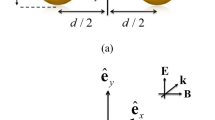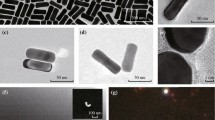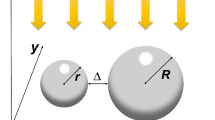Abstract
Finite element method calculations were carried out to determine extinction spectra and the electromagnetic (EM) contributions to surface-enhanced Raman spectroscopy (SERS) for 90-nm Au nanoparticle dimers modeled after experimental nanotags. The calculations revealed that the EM properties depend significantly on the junction region, specifically the distance between the nanoparticles for spacings of less than 1 nm. For extinction spectra, spacings below 1 nm lead to maxima that are strongly red-shifted from the 600-nm plasmon maximum associated with an isolated nanoparticle. This result agrees qualitatively well with experimental transmission electron microscopy images and localized surface plasmon resonance spectra that are also presented. The calculations further revealed that spacings below 0.5 nm, and especially a slight fusing of the nanoparticles to give tiny crevices, leads to EM enhancements of 1010 or greater. Assuming a uniform coating of SERS molecules around both nanoparticles, we determined that regardless of the separation, the highest EM fields always dominate the SERS signal. In addition, we determined that for small separations less than 3% of the molecules always contribute to greater than 90% of the signal.







Similar content being viewed by others
References
Albrecht MG, Creighton JA (1977) J Am Chem Soc 99:5215
Fleischman M, Hendra PJ, McQuillan AJ (1974) Chem Phys Lett 26:163
Jeanmaire DL, Van Duyne RP (1977) J Electroanal Chem 1:84
Schatz GC (1984) Acc Chem Res 17:370
Metiu H, Das P (1984) Annu Rev Phys Chem 35:507
Xu H, Aizpurua J, Kall M, Apell P (2000) Phys Rev E 62:4318
Schatz GC, Van Duyne RP (2002) In: Chalmers JM, Griffiths PR (eds) Handbook of vibrational spectroscopy. Wiley, New York
Nie S, Emory SR (1997) Science 275:1102
Kneipp K, Wang Y, Kneipp H, Perelman LT, Itzkan I, Dasari RR, Feld MS (1997) Phys Rev Lett 78:1667
Dieringer JA, Wustholz KL, Masiello DJ, Camden JP, Kleinman SL, Schatz GC, Van Duyne RP (2009) J Am Chem Soc 131:849
Kerker M, Wang DS, Chew H (1980) Appl Opt 19:3373
Doering WE, Piotti ME, Natan MJ, Freeman RG (2007) Adv Mater 19:3100
Draine BT, Flatau PJ (1994) J Opt Soc Am A 11:1491
Draine BT, Flatau PJ (2003) User guide for the discrete dipole approximation code DDSCAT.6.0. Available from: <http://arxiv.org/ags.astro-ph/0309069>
Taflove A, Hagness SC (2005) Computational electrodynamics: the finite-difference time-domain method, 3rd edn. Artech House, Inc., Norwood
Yee SK (1966) IEEE Trans Antennas Propagat 14:302
Jin J (2002) The finite element method in electromagnetics, 2nd edn. Wiley, New York
Kottmann JP, Martin OJF, Smith DR, Schultz S (2000) Opt Express 6:213
Hao E, Schatz GC (2004) J Chem Phys 120:357
Zou S, Schatz GC (2005) Chem Phys Lett 403:62
Xu H (2004) Appl Phys Lett 85:5980
Zeman EJ, Carron KT, Schatz GC, Van Duyne RP (1987) J Chem Phys 87:4189
Kottmann JP, Martin OJF (2001) Opt Express 8:655
Aravind PK, Nitzan A, Metiu H (1981) Surf Sci 110:189
Vanin AI (1995) J Appl Spect 62
Felidj N, Aubard J, Levi G (1999) J Chem Phys 111:1195
McMahon JM (2009) JFEM2D. Available from: <http://www.thecomputationalphysicist.com>
Schöberl J (2009) NETGEN. Available from <http://www.hpfem.jku.at/netgen/>
Saxon DS (1955) UCLA Department of Meteorological Science Report 9
McMahon JM, Gray SK, Schatz GC (2009) Surface nanophotonics theory. In: Wiederrecht G (ed) Comprehensive nanoscience and technology. Elsevier, Amsterdam
Lynch DW, Hunter WR (1985) In: Palik ED (ed) Handbook of optical constants of solids. Academic, Orlando
Bohren CF, Huffman DR (1983) Absorption and scattering of light by small particles. Wiley, New York
McMahon JM, Wang Y, Sherry LJ, Van Duyne RP, Marks LD, Gray SK, Schatz GC (2009) J Phys Chem C 113:2731–2735
Prodan E, Radloff C, Halas NJ, Nordlander P (2003) Science 302:419
Garcia-Vidal FJ, Pendry JB (1996) Phys Rev Lett 77:1163
Acknowledgment
This research was supported by the NSF (CHE-0414554), AFOSR/DARPA Project BAA07-61 (FA9550-08-1-0221), and NSF MRSEC (DMR-0520513) at the Materials Research Center of Northwestern University. We thank the NUANCE Center at Northwestern University for providing access to the TEM equipment.
Author information
Authors and Affiliations
Corresponding author
Electronic Supplementary Material
Below is the link to the electronic supplementary material.
ESM 1
Probability distributions of electromagnetic enhancements for nanoparticle separations from 5 to −20 nm; Percentage and number of molecules that contribute to the SERS signal for particle separations of 5 to −20 nm and molecular diameters of 0.25 to 2 nm (PDF 195 kb).
Rights and permissions
About this article
Cite this article
McMahon, J.M., Henry, AI., Wustholz, K.L. et al. Gold nanoparticle dimer plasmonics: finite element method calculations of the electromagnetic enhancement to surface-enhanced Raman spectroscopy. Anal Bioanal Chem 394, 1819–1825 (2009). https://doi.org/10.1007/s00216-009-2738-4
Received:
Accepted:
Published:
Issue Date:
DOI: https://doi.org/10.1007/s00216-009-2738-4




